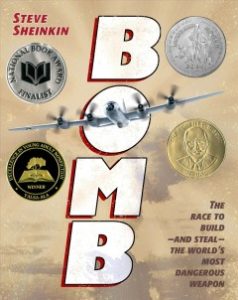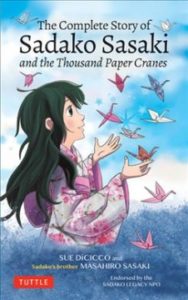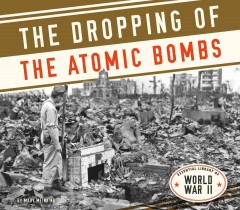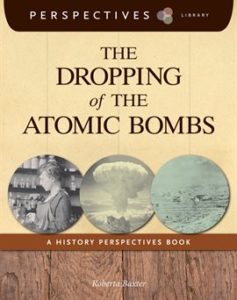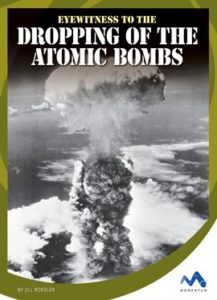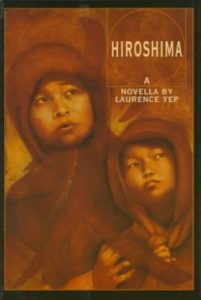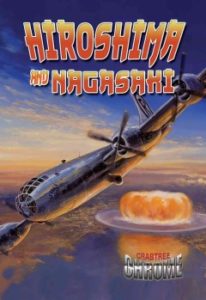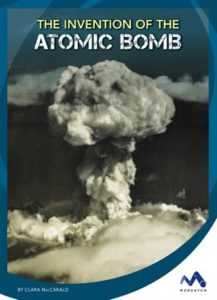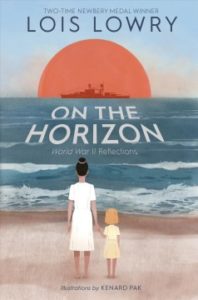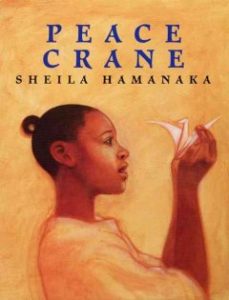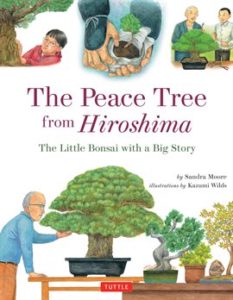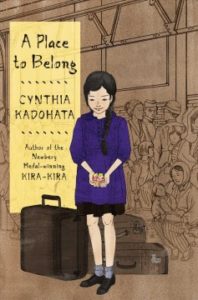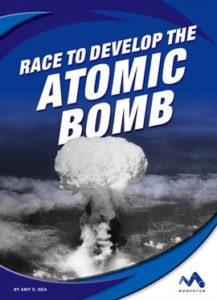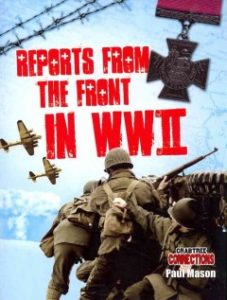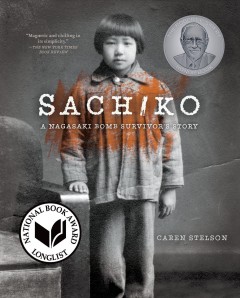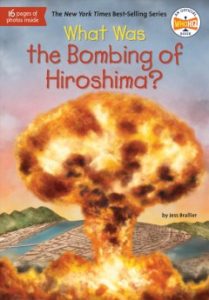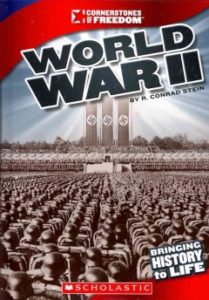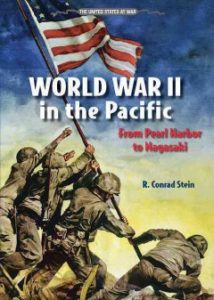Back when I was working my way through library school, I was a little shocked when a boy asked me for a book on bombs. We chatted for a bit, and I soon learned his question was really, “Could nuclear war destroy everything?” At the time, worries about war with Iran had been in the news. The library where I worked at the time didn’t have a lot of books on nuclear weapons, but I was able to find him some personal stories of survivors of the bombing of Hiroshima.
This month we are marking 75 years since the bombings of Hiroshima and Nagasaki. Children may see these events commemorated and wonder about them. Some authors are using the anniversaries as a moment to reflect on events in new books and tell personal or family stories. You can find plenty of nonfiction, including books honored with a Sibert medal. Click on the book covers or titles below for more information.
Bomb: The Race to Build—and Steal—the World’s Most Dangerous Weapon
by Steve Sheinkin
Honored with multiple awards, this is the story of the race between countries, spies and scientists to create the first atomic bomb. Suggested for grades 5 and up.
The Complete Story of Sadako Sasaki and the Thousand Cranes
by Sue DiCicco and Sadako’s brother Masahiro Sasaki
Older generations may have read Sadako and the Thousand Paper Cranes; this telling bring’s a family member’s perspective to the story of a young atom bomb survivor, her suffering from leukemia, her wish for peace and her legacy. Suggested for grades 4 and up.
The Dropping of the Atomic Bombs
by Mary Meinking
This title examines the dropping of atomic bombs during World War II, focusing on their development and testing, the bombing missions and the bombs’ destruction and legacy. (This title is also available from hoopla). Suggested for middle school and up.
Perspectives: The Dropping of the Atomic Bombs
by Roberta Baxter
Readers learn details through the point of view of a Manhattan Project scientist, a witness in Hiroshima, and an aide to the US secretary of war (available from hoopla). Suggested for grades 4 and up.
Eyewitness to the Dropping of the Atomic Bombs
by Jill Roesler
Through narrative nonfiction text, readers learn about the dropping of atomic bombs on Hiroshima and Nagasaki through the perspectives of American and Japanese leaders, scientists, U.S. Army officials, and Japanese citizens (available from hoopla). Suggested for grades 4 and up.
Hiroshima: A Novella
by Laurence Yep
Describes the dropping of the atomic bomb on Hiroshima, Japan, particularly as it affects Sachi, who becomes one of the Hiroshima Maidens. Suggested for grades 4 to 6.
Hiroshima and Nagasaki
by Lynn Peppas
Describes the bombing of these Japanese cities by the United States during World War II, discussing the development of the atomic bomb, what happened when the bombs were dropped, and the long term consequences. A high interest book with limited vocabulary for aspiring readers
Hiroshima No Pika, an animated film based on a picture book by the same title, is available from Kanopy. Suggested for grades 3 and up.
The Invention of the Atomic Bomb
by Clara MacCarald
This book approaches atomic weapons as a feat of engineering (available from hoopla). Suggested for grades 4 and up.
On the Horizon
by Lois Lowry
Lois Lowry draws from her own memories as a child in Hawaii and Japan to reflect, in poetry, on the bombings of Pearl Harbor and Hiroshima. Suggested for grades 4 to 6.
Peace Crane
by Sheila Hamanaka
After learning about the Peace Crane, created by Sadako, survivor of the bombing of Hiroshima, a young African American girl wishes it would carry her away from the violence of today’s world. Suggested for grades 2 and up.
Peace Tree from Hiroshima
by Sandra Moore
Miyajima, a white pine, recounts how it grew nearly four hundred years ago, was made into a bonsai by a man named Itaro and cared for by his family, survived the bombing of Hiroshima, and was given to the National Arboretum in Washington in 1976 (available from hoopla). Suggested for kindergarten to grade 3.
A Place to Belong
by Cynthia Kadohata
Twelve-year-old Hanako and her family, reeling from their confinement in an internment camp, renounce their American citizenship to move to Hiroshima, a city devastated by the atomic bomb. Suggested for grades 5 and up.
Race to Develop the Atomic Bomb
by Amy C. Rea
Offers readers a captivating look into the race between three countries to build the world’s most destructive weapon (available on hoopla). Suggested for grades 4 and up.
Reports from the Front in WWII
by Paul Mason
Describes major events in World War II, including the bombing of Nagasaki. Suggested for grades 3 to 6.
Sachiko: A Nagasaki Bomb Survivor’s Story
by Caren Stelon
The true story of six-year-old Sachiko Yasui’s survival of the Nagasaki atomic bomb on August 9, 1945, and the heartbreaking and lifelong aftermath. Suggested for grades 5 and up.
What Was the Bombing of Hiroshima?
by Jess M. Brallier
In a thoughtful account of these history-changing events, Jess Brallier explains the leadup to the bombing, what the terrible results of it were, and how the threat of atomic war has colored world events since. Suggested for grades 4 and up.
World War II
by R. Conrad Stein
An overview of the events of World War II, also available with additional resources on FreedomFlix. Suggested for grades 4 and up.
World War II in the Pacific: From Pearl Harbor to Nagasaki
by R. Conrad Stein
Examines World War II in the Pacific, including the causes of the war between Japan and the United States, the important battles and leaders, life for soldiers and life on the homefront, and how the war ended. Suggested for middle school and up.

